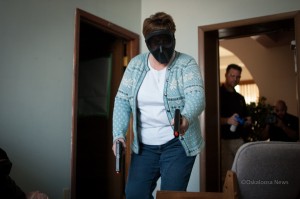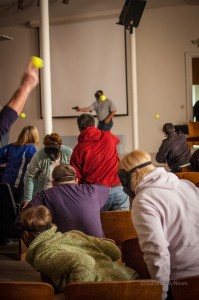Training To Survive An Active Shooter

This was the view as students sat in a classroom at the old Vennard College during a portion of ALICE training on Wednesday morning.
Oskaloosa, Iowa – How to survive an active shooter situation was the focus of a two day class held on the former campus of Vennard College in University Park. There were a total of 51 participants from various parts of the state and different forms of public service, from law enforcement to paramedics.
Mahaska County Emergency Management organized the class that is designed to train those participating, who will then return to their local areas and instruct others about ALICE (alert, lockdown, inform, counter, evacuate).
Shawn Slezak is a trainer with Response Options and lead the class of future ALICE trainers. Response Options a company out of Texas that describes themselves as, “a critical incident response training company, specializing in active shooter and violent intruder response strategies. “We are prepared to train your organization, or speak at your event, and provide an experienced, professional level of support.”
Slezak says that ALICE “provides options to people in any setting; school, church, business, any place you can possibly be where an active killer comes in. Instead of mandating one response to cover every solution, it’s a variety of options.” Slezak says those options may help in survivability chances in the case of an active shooter.
Slezak said that last year there were a total of six ALICE schools taught in Iowa, but since then the Iowa Department of Homeland Security has sponsored over 20 classes until July of this year. Slezak says that some states, such as Ohio, have approximately twenty percent of their student population trained in ALICE, saying that nationwide, 1.5 million K-12 students are trained in ALICE.
Response Options was started in 2000, but with the recent shootings, like those in Connecticut, “people are really looking for a program that is going to provide options and training on how they can survive a situation like that.” says Slezak.
During an instructor training course like the one held over the past two days, the first day is class work. After a review of the information given out on the first day, the second day of training has students participating in different scenarios that showcase how that information learned can be put to use in the case of an active shooter.
The final step of the process, in training future instructors, is having the students then take a portion of the program and teach it to their fellow class members.
Once the two day class is completed, Slezak says the trainers will then be, “certified through Response Options to go back into the community… and they train [community members].”
I asked Slezak why he would encourage schools to have ALICE training. “It empowers everybody within that school to make a decision, based off their real time information, to heighten their survivability chances.”
Slezak says that by empowering students to do what they know is right, “which is, many times evacuate the building, we’re going to heighten their survivability.”
Jamey Robinson, Director at Mahaska County Emergency Management said, “I hosted the ALICE training because I knew this is the direction I would like to see schools and businesses go towards.”
Robinson said that landing that class here in Mahaska County wasn’t easy, considering the recent demand for the training, and he worked to hold the class here, over surrounding locations, so that “we could have it right here in the heart of Mahaska County”.
” I believe this class was a huge success and wish we could get more people to the training so they can understand the importance of better preparing our teachers, students, employers, and colleges in this training. This is something that should have been started a long time ago and I hope that we can get everyone on board with it. I as a father I know the importance of this because it would give my children more options than climbing under a desk, hiding, and praying nothing happens. Statistics have shown this method doesn’t work. The ALICE training will show key players that there are more options to take, it shows them how to be proactive instead of passive,” Robinson explained.
During the days exercises, the class progressed through different scenarios. The first was a traditional lockdown, were students attempted to hide, crawled under desks in order to not be shot. During that exercise, approximately 30 of the students were ‘shot’.
As the scenarios progressed, additional portions of the ALICE training were implemented. The second scenario allowed students to make choices on if they could escape, or barricade themselves into a room in an attempt to survive, and the survivability rate of the class increased.
Another scenario that was played out allowed students to toss objects at an armed attacker, then choose to escape or counter the attacker. This is done by students rushing the attacker, then once the attacker is distracted, subduing them.
The counter portion of ALICE is the most controversial portion of the training.
During our scenario on Wednesday, when the class distracted the attacker with a barrage of thrown objects, in this case tennis balls, and a group of individuals then swarmed the attacker, those who would have suffered potentially fatal gunshots dropped to two students, with three others being wounded. The “active shooter role” was played by an active law enforcement official, and helped to demonstrate that even a trained professional could be distracted and subdued by using the tactics.
The concept of throwing objects and distracting an active shooter came from data that showed that a member of law enforcement who was engaged in a shooting had their senses overloaded and had a much lower accuracy rate with their firearm.
Robinson said, of the demonstration of the full use of ALICE, ” That is a huge difference and that was with a trained proficient guy using the gun, most shooters are not of that caliber.”
” I would encourage any business, school, or organization to contact my office if they have any questions or would like me to come present something to a group,” Robinson said.
You can contact the Mahaska County Emergency Management office at, (641) 672-1209.











